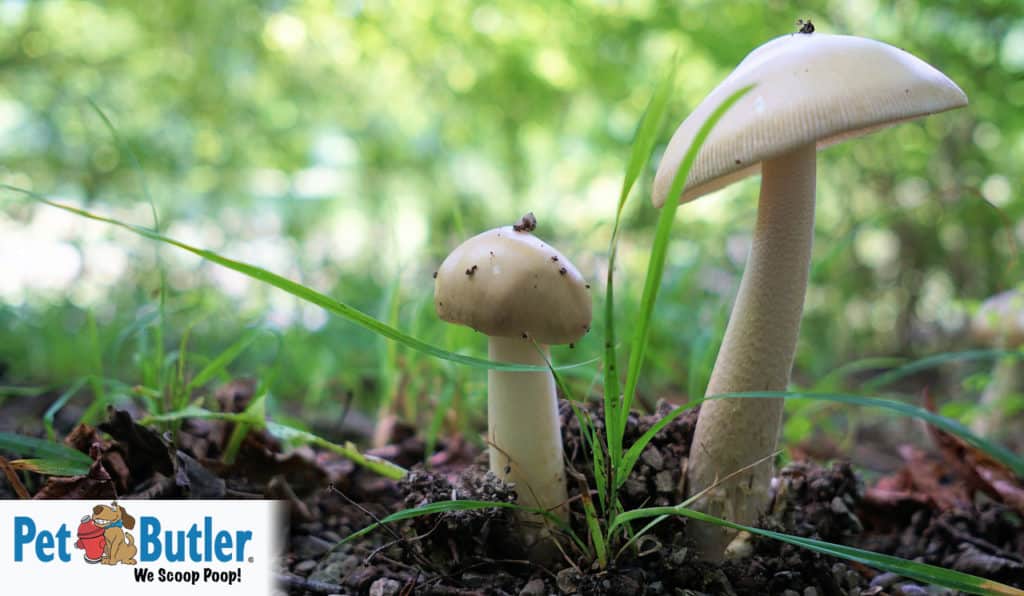As we know, summer and fall bring a unique set of seasonal scares for pet owning families. In addition to an increase in parasite exposure such as fleas and ticks, wild animal encounters, and dog park injuries, exposure to certain environmental toxins also peaks.
Toxic mushrooms are one such hazard and they multiply in the warm, wet weather season. Although they don’t do much to harm your lawn, be alert for signs of poisonous mushrooms and toxic plant growth as symptoms of toxicity can mimic other types of poisons and diagnosis can be challenging!
Watch Out For Toxic Mushrooms
There are four classes of poisonous mushrooms; the classes are based on the type and severity of symptoms they cause.
Additionally, mushrooms can be classified into groups, separated by the type of toxin they contain. Poisonous varieties include:
- False Morels
- Hallucinogenic Mushrooms
- Toadstool Mushrooms
- Liver Toxic Mushrooms and those that cause gastrointestinal signs or are muscarinic containing species.
Identification of the type your dog has consumed can be difficult once they pass your pet’s lips; treat any mushroom ingestion as a poisonous species and call your veterinarian immediately.
Another after-hours alternative is to call the National Animal Poison Control Center hotline at (888) 426-4435. They are open 24/7 and 365 days a year and charge a nominal fee to advise you on how to manage your pet’s ingestion.
If a sample of the mushroom is available, consider contacting the North American Mycological Association to aid in identification.
Hepatoxic Mushrooms
The deadliest class of mushrooms are those that cause liver failure (hepatotoxic) with signs precipitating in 6-12 hours. At this point, inducing vomiting with hydrogen peroxide or slowing toxin absorption with activated charcoal given orally is fruitless.
Once an animal has started to show signs of poisoning, it is no longer safe or advisable to try to expel the offending agent. With names like “death cap” and “death angel”, liver cell death and eventual mortality can occur within a day or two, after being preempted by gastrointestinal upset.
These mushrooms are found throughout North America including the Pacific Northwest, parts of California and the northeastern part of the United States.
Neurotoxic Mushrooms
These affect the nervous system due to the compounds they contain and include psilocybin (“magic”), hydrazine and isoxazole mushrooms.
Magic or psychedelic mushrooms are often found indoors as part of a pet owner’s “pharmacy”. Others grow throughout the United States, but favor the West and Northeast. Symptoms of ingestion are typically seen within 30-90 minutes, but effects can last hours longer.
Varying from initial gastrointestinal upset to weakness, stupor, tremors, disorientation, vocalization and seizures, these mushrooms are typically less toxic but severity of illness depends on the amount ingested and the dog’s size and health status.
Gastrointestinal signs such as vomiting and diarrhea are seen early on after the ingestion of most mushrooms (15 minutes to less than 6 hours).
Muscarinic containing mushrooms not only cause mild to severe vomiting and diarrhea, but ingestion can lead to dehydration, excessive salivation, tearing, urination, slow heart rate and difficulty breathing depending on the type and amount consumed.
Nephrotoxic Mushrooms
Our last class of mushrooms, the nephrotoxic (kidney) varieties, are thankfully rare with poisoning reported in Europe. Signs of toxicity are delayed by up to 8 days as the kidney cells are destroyed.
Symptoms of poisoning are typical of a dog in kidney failure and include vomiting, increased thirst, and urination; dogs can succumb if not treated aggressively with fluid therapy and hospitalization.
If caught within the first hours of ingestion, decontamination by inducing vomiting and delaying intestinal absorption, managing symptoms, and blood and urine sample monitoring are often successful at managing mushroom poisoning in dogs.
As always, be on the lookout in your yard for anything unusual underfoot!




